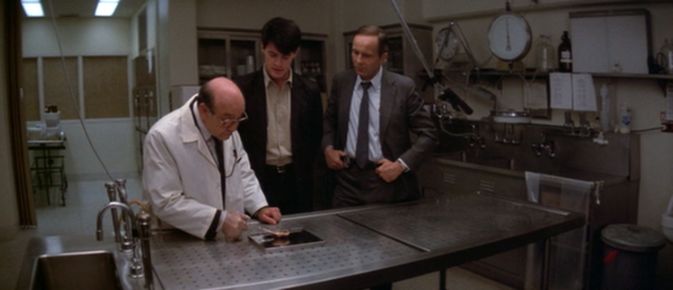 Back to selection
Back to selection
The Blue Velvet Project
Blue Velvet, 47 seconds at a time by Nicholas Rombes
The Blue Velvet Project, #11

Second #517, 8:37
Peter Carew, who plays the coroner and who appears onscreen for just under twenty seconds, delivers perhaps the most tilted line in the movie: “We’ll check the morgue records but I don’t recall anything coming in minus an ear.” This either could be the punch line to the whole sordid blood-drenched twentieth century, or else a few words tossed off by a bald man who refuses to look at the characters on screen with him, as if he speaks to (into?) the ear and the ear alone. Blue Velvet was Carew’s first movie in twenty years. Previously, he had starred in the soft-core movie Teenage HitchHikers (1975) as Dick Daggard, a clothier of some sort. The scene from which second #517 is taken was shot in the New Hanover Memorial Hospital in Wilmington, North Carolina (now the New Hanover Regional Medical Center).
In his sweeping and magisterial essay “The Ontology of the Photographic Image” (1945), André Bazin wrote:
Perspective was the original sin of Western painting. It was redeemed from sin by Niepce and Lumière. In achieving the aims of baroque art, photography has freed the plastic arts from their obsession with likeness. Painting was forced, as it turned out, to offer us illusion and this illusion was reckoned sufficient unto art. Photography and the cinema on the other hand are discoveries that satisfy, once and for all and in its very essence, our obsession with realism.
Here, as in the shot from the previous entry, realism is heightened to such a level that it approaches the archetypal, and almost turns around to become a parody of itself: the coroner in his coroner whites, the stainless steel examination table, the scale and other symbols of the profession in the background, as well as the enigmatic red object protruding from the garbage can at the lower right (the tied-off portion of a red plastic garbage bag)? If anything, Blue Velvet toys with our “obsession with realism,” rendering the real world just a beat off, like a record that (beyond all reason) keeps playing and making noise for a split second after the tone arm has lifted. In Bazin’s universe, photographic realism allowed art to burst free of realism into abstraction. And although there is nothing overtly surreal about this frame, something about it feels just wrong enough to serve as a warning. And an invitation.
Over the period of one full year — three days per week — The Blue Velvet Project will seize a frame every 47 seconds of David Lynch’s classic to explore. These posts will run until second 7,200 in August 2012. For a complete archive of the project, click here. And here is the introduction to the project.
